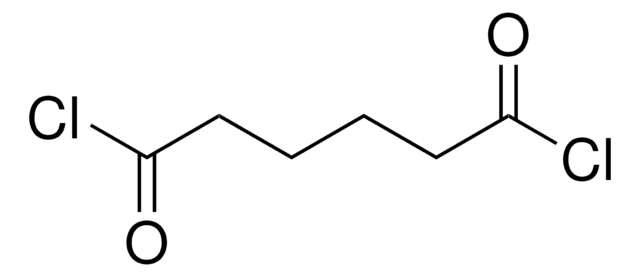247731
Hexamethylenediamine dihydrochloride
99%
Synonym(s):
1,6-Hexanediamine dihydrochloride
Sign Into View Organizational & Contract Pricing
All Photos(3)
About This Item
Linear Formula:
H2N(CH2)6NH2 · 2HCl
CAS Number:
Molecular Weight:
189.13
EC Number:
MDL number:
UNSPSC Code:
12352100
PubChem Substance ID:
NACRES:
NA.22
Recommended Products
assay
99%
mp
256-257 °C (lit.)
solubility
water: freely soluble
functional group
amine
SMILES string
Cl.Cl.NCCCCCCN
InChI
1S/C6H16N2.2ClH/c7-5-3-1-2-4-6-8;;/h1-8H2;2*1H
InChI key
XMVQMBLTFKAIOX-UHFFFAOYSA-N
General description
Toxicity of hexamethylenediamine dihydrochloride has been investigated. Hexamethylenediamine dihydrochloride is also known as 1,6-diaminohexane dihydrochloride, 1,6-hexamethylenediamine dihydrochloride, 1,6- hexylenediamine dihydrochloride or 1,6-diamino-n-hexane dihydrochloride. Hexamethylenediamine dihydrochloride on fusion of 1:6-di-(N3-cyano-N1-guanidino)-hexane yields polymeric diguanides.
signalword
Warning
hcodes
Hazard Classifications
Eye Irrit. 2 - Skin Irrit. 2 - STOT SE 3
target_organs
Respiratory system
Storage Class
11 - Combustible Solids
wgk_germany
WGK 3
flash_point_f
Not applicable
flash_point_c
Not applicable
ppe
dust mask type N95 (US), Eyeshields, Gloves
Choose from one of the most recent versions:
Already Own This Product?
Find documentation for the products that you have recently purchased in the Document Library.
Customers Also Viewed
850. Bisdiguanides having antibacterial activity.
Rose FL andSwain G.
Journal of the Chemical Society, 4422-4425 (1956)
Charles Hebert
Toxicity report series, 24, 1-D8-1-D8 (1993-03-01)
1,6-Hexanediamine (HDA) is an aliphatic amine that is produced in large volumes in the United States. HDA is widely used as a corrosion inhibitor in lubricants and as an intermediate in the industrial synthesis of paints, resins, inks, and textiles.
Bo Tao et al.
Polymers, 12(5) (2020-05-20)
Dopamine-modified hyaluronic acid (HA-DOP) was chosen as the drug carrier in this study, and Cu2+ was selected from among Cu2+, Zn2+, Fe2+, and Ca2+ as the central atom. 6-Mercaptopurine (6-MP) was conjugated with HA through a coordination reaction. HA-DOP-copper-MP (HA-DOP-Cu-MP)
Huina Zhang et al.
Biomaterials, 30(25), 4063-4069 (2009-06-03)
We previously established a simple method to immobilize the Arg-Gly-Asp (RGD) peptide on polycaprolactone (PCL) two-dimensional film surfaces that significantly improved bone marrow stromal cell (BMSC) adhesion to these films. The current work extends this modification strategy to three-dimensional (3D)
Linda G T Gaines et al.
Journal of environmental monitoring : JEM, 12(3), 591-599 (2010-05-07)
Urine amine levels used as biomarkers of diisocyanate exposure have usually been normalized with creatinine concentration. The suitability of using creatinine concentration or specific gravity for these biomarkers in exposure assessment has not been established. We investigated the effect of
Our team of scientists has experience in all areas of research including Life Science, Material Science, Chemical Synthesis, Chromatography, Analytical and many others.
Contact Technical Service











